INVESTIGATIONS
Shelling a market in Taiz Old City of Taiz governorate
February 16, 2023Shelling a market in Taiz Old City of Taiz governorate
Print Article
- Incident: Shelling a market in Taiz Old City of Taiz governorate
- Location: Al-Luqma market in Al Bab Al Kabeer, Al Mudhaffar district, Taiz governorate
- Date: 3 June 2016
- Time: Between 03:20 and 03:32 pm local time
- Type: Artillery shelling
- Potential munition: 122 mm howitzer
- Victims: Allegedly 9 killed, including a child and two women, and 11 injured, including a child and two women
- Potentially Responsible: the Houthi-Saleh forces
Introduction
On the evening of 3 June 2016, a crowded popular market in Taiz Old City in Al Mudhaffar district of Taiz governorate was shelled allegedly with artillery, as part of a series of attacks on the city. The shelling on the market caused civilian casualties, including children and women.
About the area
Taiz Old City is located in Al-Mudhaffar district, in Taiz governorate. The city has several main gates, including Bab Musa and Al-Bab Al Kabeer. Al-Luqma market is located 130 meters from Al-Bab Al-Kabeer. The Old City’s residents shop from this market throughout the year. The market is on a road linking the eastern part of the Old City with the rest of Taiz city. Every day, thousands of civilians pass this road.
Taiz Old City was one of the areas which the armed confrontations did not reach, and it was within the geographical area under the control of the Government Army and the Popular Resistance since the first days of the war, except for the historic Al-Qahira Castle, which was controlled by the Houthi-Saleh due to its strategic location, overlooking the city. The Popular Resistance forces loyal to the IRGY took control of Al-Qahira Castle in August 2015.
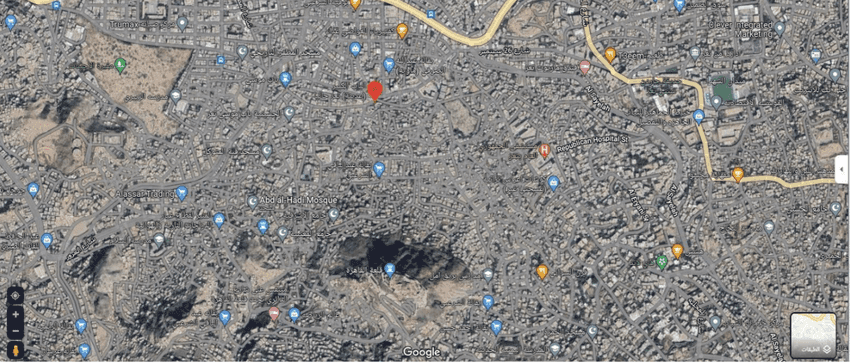
Figure A100 A satellite image from Google Maps, showing Al-Qahira Castle overlooking the Old City, Bab Musa (western entrance) and Al-Bab Al-Kabeer (eastern entrance).
The Incident
On the morning of 3 June 2016, military confrontations started east of Taiz city, during which shelling of residential neighborhoods continued until midnight. In the evening, one of the shells fell on Al-Luqma market, near Al-Bab Al-Kabeer, the eastern entrance to Taiz Old City, killing and injuring civilians, including children and women.
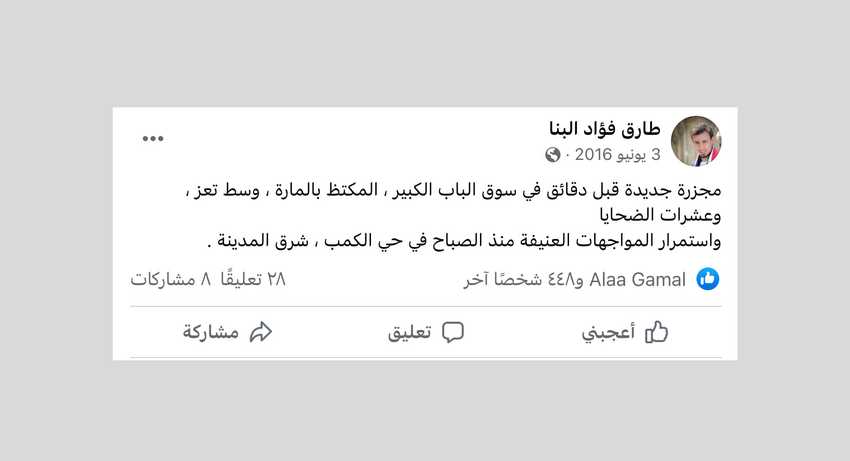
Figure A101 A screenshot of Tariq Fouad Al-Banna’s Facebook post.
This Facebook post explains that a massacre occurred in the crowded Al-Bab Al-Kabeer Market, located in the center of Taiz, leading to dozens of victims. It claims that violent confrontations had begun that morning in the Al-Kamb neighborhood, east of the city.
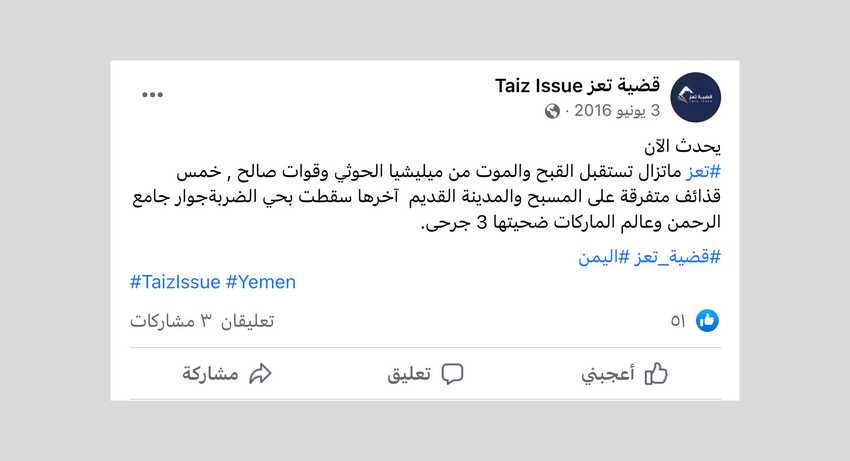
Figure A102 A screenshot of Taiz Issue Facebook post
This facebook post claims that, in Taiz, the Houthi militia and Saleh forces fired five separate shells, hitting Al-Masbah and the old city. The last of these shells fell in the Al-Darba neighborhood, next to Al-Rahman Mosque and Alam Al-Marakat, wounding 3 people.
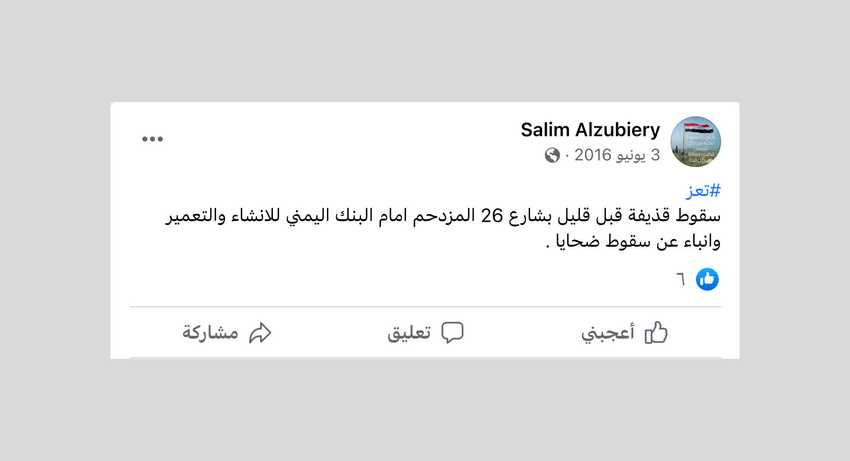
Figure A103 A screenshot of Salim Alzubiery’s Facebook post
This Facebook post claims that, in Taiz, a shell had just recently fallen on a crowded street, Street 26, which is in front of the Yemeni Bank for Reconstruction and Development. It states there were reports of casualties.
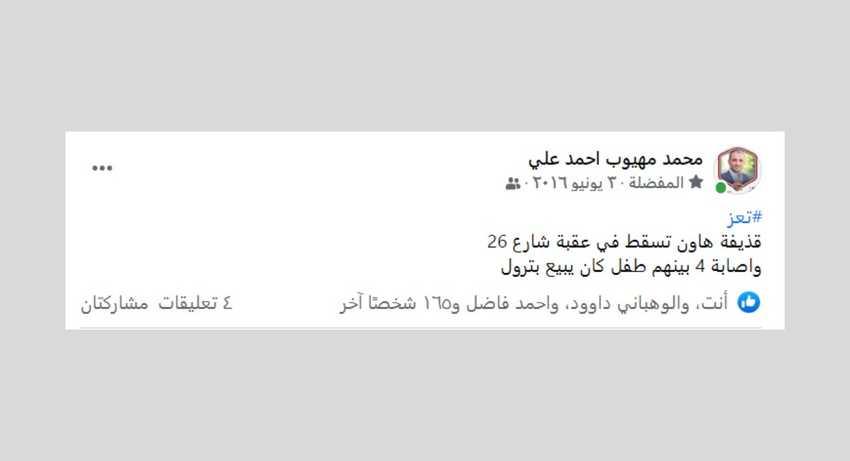
Figure A104 A screenshot of Mohamed Mahyoub Ahmed Ali’s Facebook post
This Facebook post claims that a mortar shell had fallen on Street 26 in Taiz. It claims 4 were injured, including a child who was selling oil.
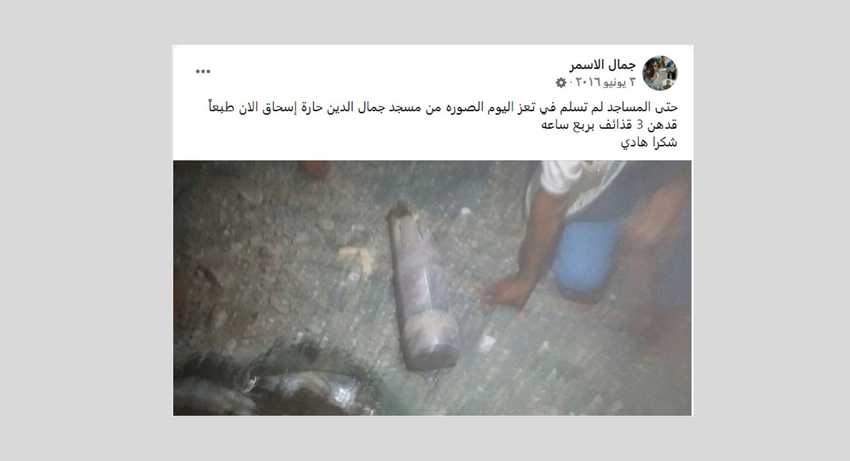
Figure A105 A screenshot of Jamal Al Asmar’s Facebook post
This Facebook post states that ‘even the mosques were not spared in Taiz today’. It claims that 3 shells hit the mosque within 15 minutes’ time. The picture displayed is from the Jamal Al-Din Mosque in the Ishaq neighborhood in Taiz.
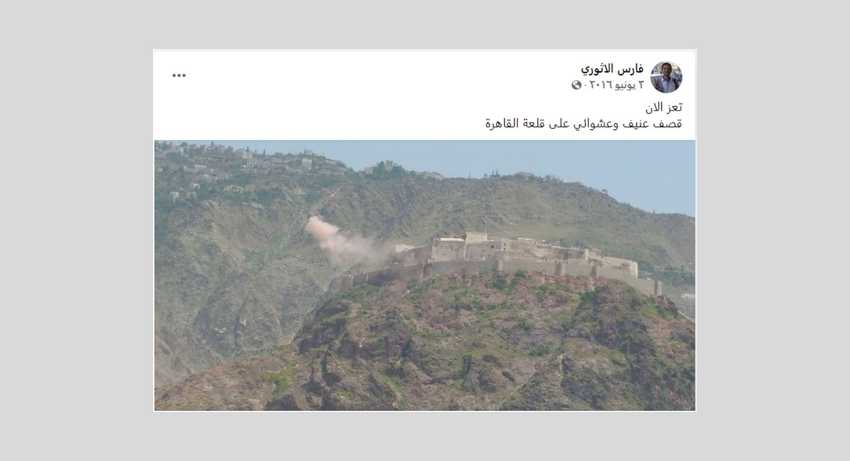
Figure A106 A screenshot of Faris Al-Athori’s Facebook post
This Facebook post states that at the time of the post, a random violent bombing was being carried out in Taiz, on the Qahira Citadel (castle)
Geolocation of the incident
Based on the visual content in YouTube videos by Al Jazeera Mubasher TV and Belqees TV that showed the market, Yemeni Archive identified the location in which the shell fell at coordinates: 13.572639, 44.011874, 130 meters south of Al-Bab Al-Kabeer within the wall of Taiz Old City.
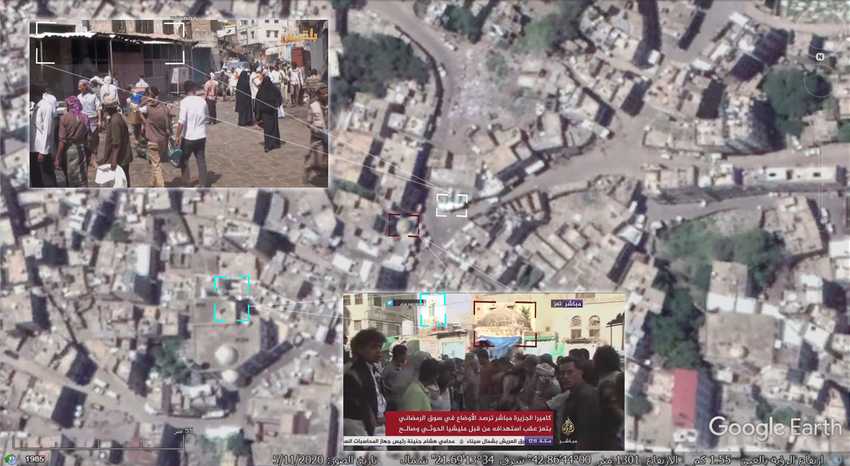
Figure A107 Screenshots from YouTube videos by Al-Jazeera Mubasher TV and Belqees TV, and a satellite image from Google Earth showing the market location in Taiz city center
Incident date and time
Fares Al-Athori published on Facebook a photo showing the moment a projectile fell in the city. By analysing the image, it is clear that the smoke was rising from Al-Luqma market behind Al-Bab Al-Kabeer. Al-Athori’s post was one of the first reports about the incident on 3 June 2016 at 03:32:55 pm, based on the Unix Timestamp Converter analysis tool. The time range for shelling was between 03:20:00 - 03:32:55 pm, local time.
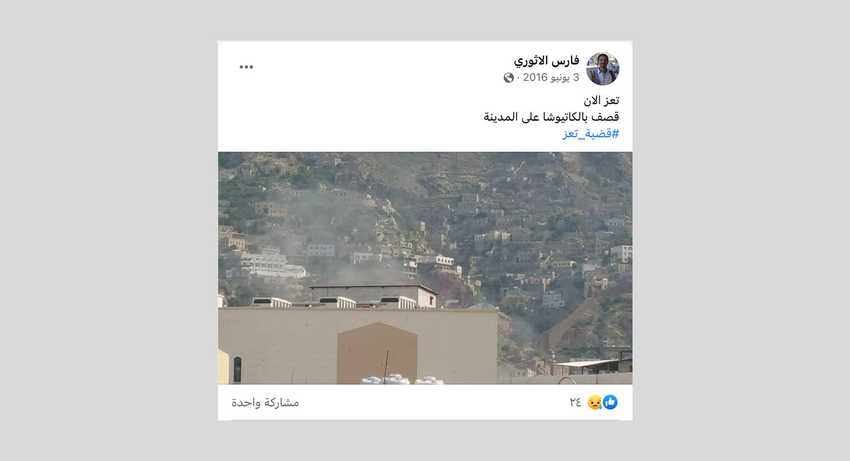
Figure A108 Screenshot of Faris Al-Athori’s Facebook post
This Facebook post claims that at the time of the post, there was Katyusha shelling on the city in Taiz.

Figure A109 Screenshot from Unix Timestamp Converter, showing the time the post was published at 03:32:55 pm, 3 June 2016
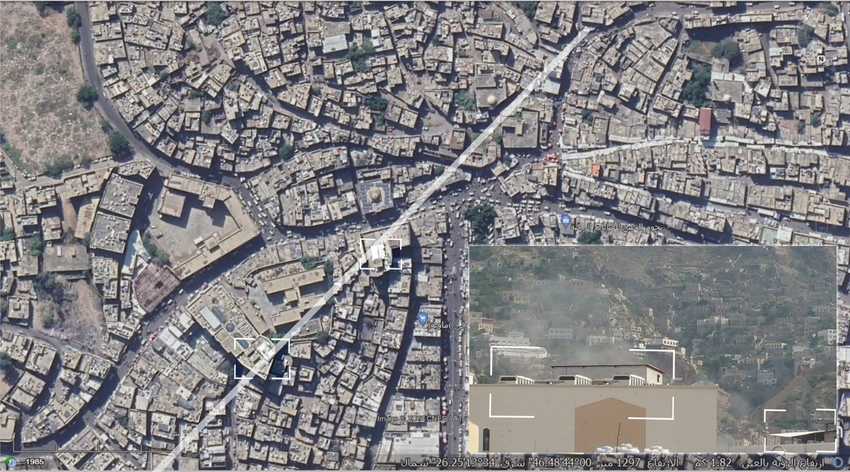
Figure A110 Satellite image from Google Earth, and a photo from Fares Al-Athori’s Facebook showing the location of the projectile impact. Smoke can be seen in the photo
3 June coincides with 27 of Shaban month of the Islamic calendar, that is, three days before the start of Ramadan, which is observed by Muslims as a month of fasting. As Al Jazeera’s reporter mentions in this video, markets in the days before the start of Ramadan get heavily crowded with people buying food and goods for Ramadan supplies. In Yemen, the shopping peak time starts after 3 pm, which means that the market at the time of the attack was at its peak time.
Potential munition used
Analysis of open source content related to this incident did not find photos or videos of the remnants of the projectile. However, several news reports show the extent of the destruction in the stone pavements 6-8 metres from the impact point. Screenshots below from their reports show how the debris was scattered around the site. Based on analysis of these open sources, it seems unlikely that the projectile was a mortar shell.
Below, in Figure A111, are screenshots from videos by Yemen Shabab TV, Belqees TV, Belqees 2 TV, Sharjah 24 News, images from Khaled Fouad Al-Binaa, and a satellite image from Google Earth, showing how fragmentation flew south, west and southeast. This appears to be in contrast to how mortar fragmentation of the shell might fly in all directions.
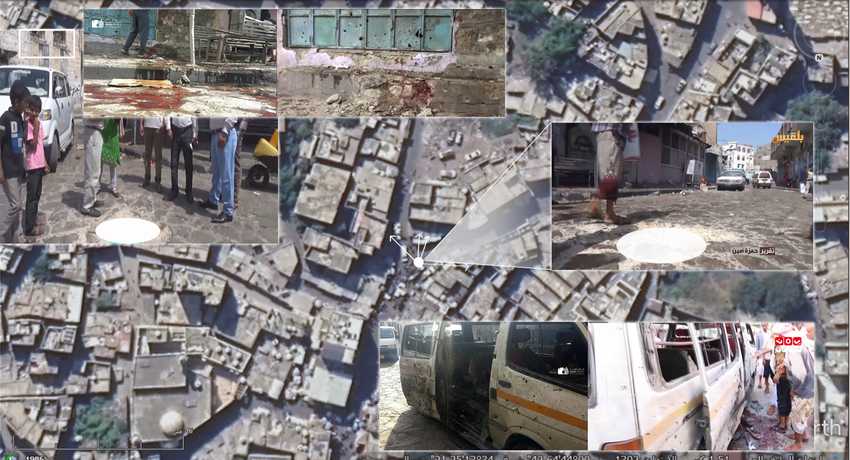
Figure A111
By tracing the incidents on the same day in Taiz city, it was found that Taha Saleh’s post (Figure A112) shared information about a second shell that fell minutes later near the market. Journalist Ahmed Al-Basha from Taiz, who documented the incident in Al-Luqma market, stated that the second shell hit the staircase leading to the roof of Hayel School for girls. The location in which the shell fell appears to be at the coordinates 13.571071, 44.009967 about 240 meters from the market.
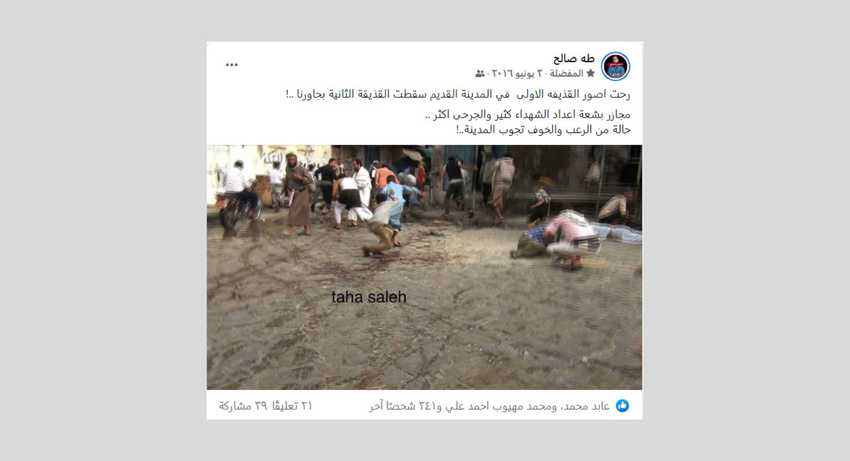
Figure A112 Screenshot of Taha Saleh’s Facebook post
This Facebook poster claims that when he had gone to photograph the first shell in the old city (Taiz), the second shell landed next to himself and these other civilians. He describes the attacks as heinous massacres, with many dead and even more wounded. He describes a state of terror and fear in the city.
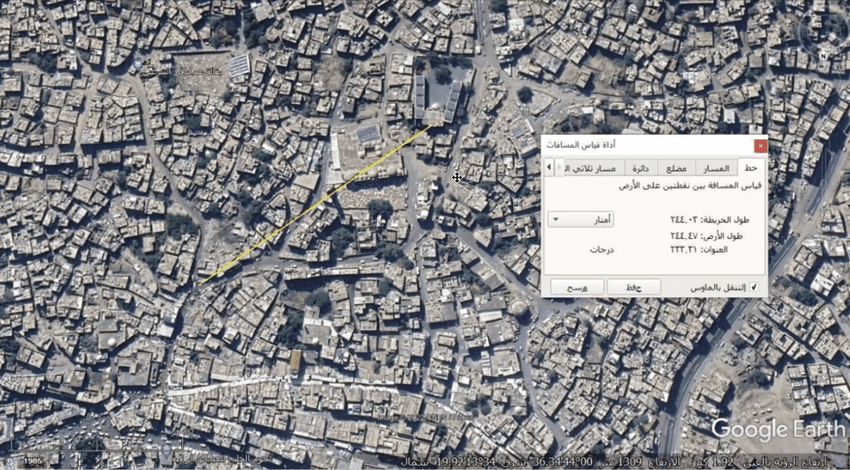
Figure A113 Satellite image from Google Earth, showing the distance between Hayel complex school and Al-Luqma market.
At about 10:00 pm on the same day, a third shell fell unexploded on Jamal al-Din mosque, 84 meters from the market. Examination of open source analysis appeared to show evidence that the unexploded shell was an old 122mm howitzer shell of type OF-462A. By comparing the visual evidence of the shell from the mosque (Figure A113) with existing photos of 122mm howitzers, (Figure A114) the Yemeni Archive team found that it looked similar to a 122mm howitzer. The three impacted sites (the school - the market - the mosque) formed a straight line, with a negligible horizontal deviation and a difference in vertical distance. The precision of the trajectory of the three shells suggests that the three sites were shelled by howitzers, contrary to what some sources suggested that the shell which hit the market was a Katyusha missile (BM-21 grad). Katyusha missiles are “blind weapons” and lack precision.
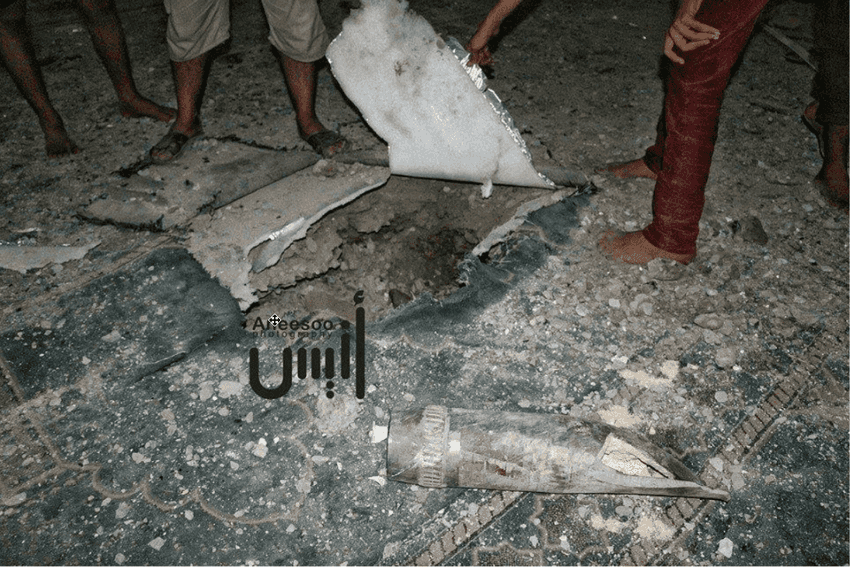
Figure A114 Photo from Anis Al Shaer’s Facebook account, showing the shell that fell on Jamal Al-Din mosque and did not explode
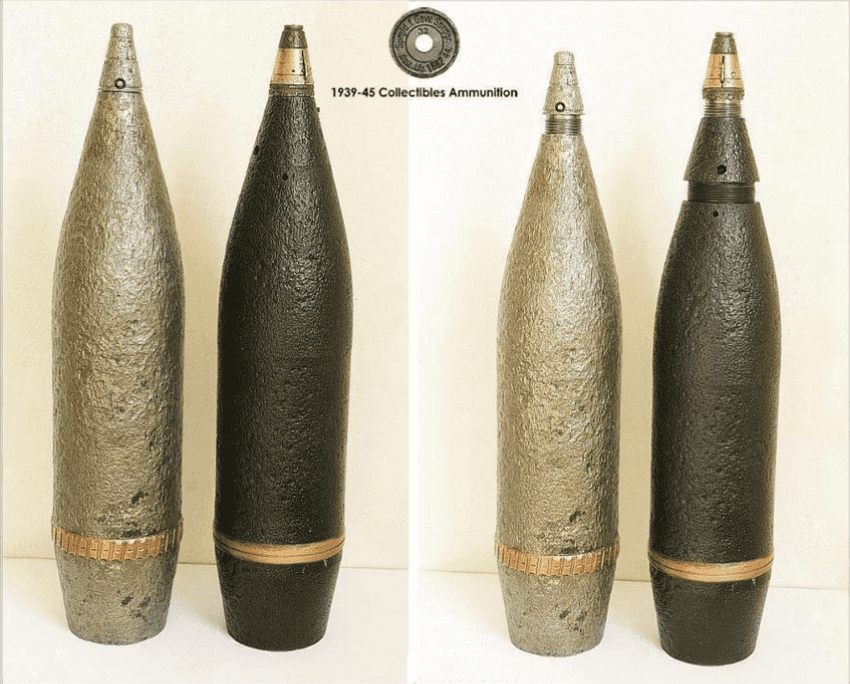
Figure A115 Photo from 1939-45 Collectibles Ammunition Facebook account, showing projectiles 122mm OF-462 and O-462A
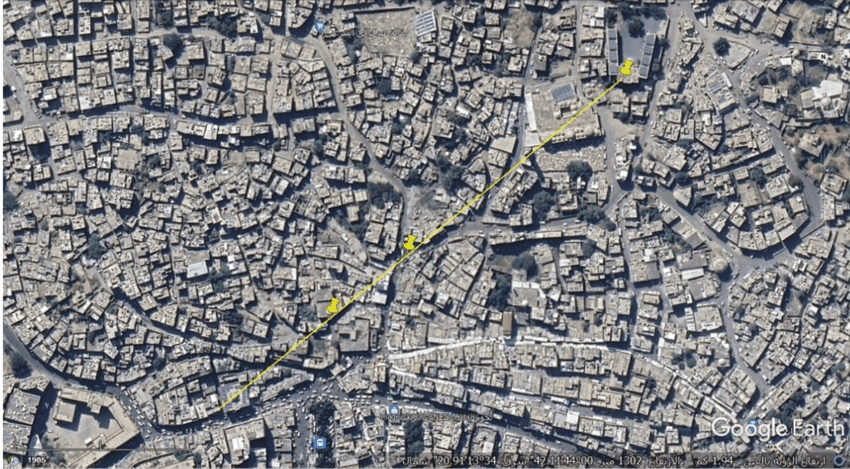
Figure A116 Satellite image from Google Earth, showing the three impact sites in a straight line, on the same day the market was shelled
Victims
Many civilian casualties were reported in different areas of Taiz city. The estimated number of the victims of Al-Luqma market differed. However, a report by the Yemeni Coalition for Monitoring Human Rights Violations about the market incident, said that 9 civilians, including a child and two women were killed, and 11 civilians, including a child and two women.
Killed:
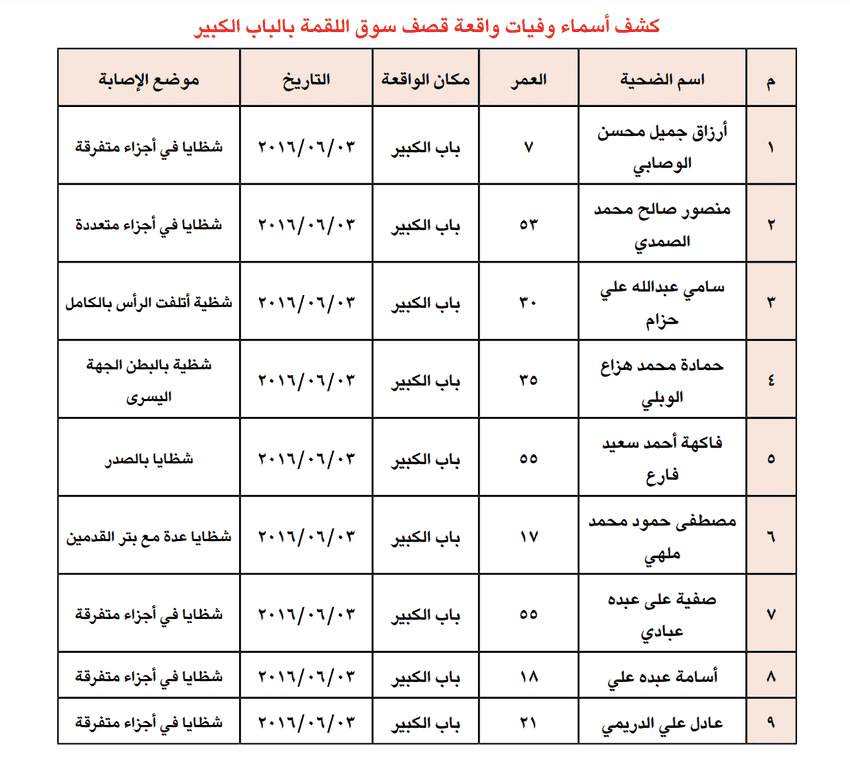
Figure A117 Screenshot from Yemeni Coalition to Monitor Human Rights Violations report showing details of those killed in Al-Luqma market
Injured:
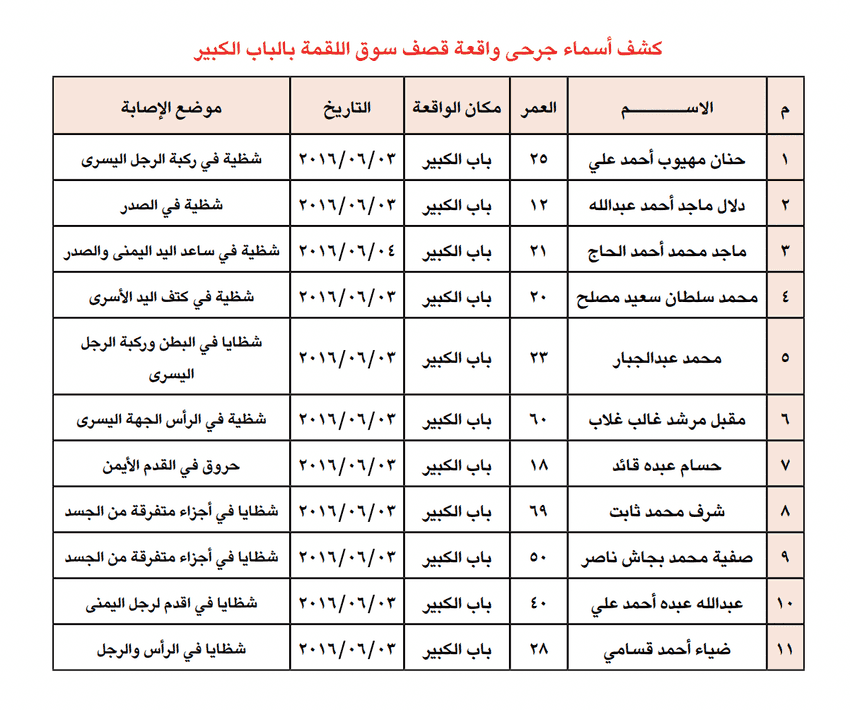
Figure A118 Screenshot from Yemeni Coalition to Monitor Human Rights Violations report showing details of those injured in Al-Luqma market
Allegedly responsible
As mentioned earlier, the Yemeni Archive team’s analysis of open-source evidence supported findings that the three shells fell in a straight vertical line, which means that they came from the same cannon. A photo from Anis Al Shaer’s Facebook post (Figure A119, below) inside the mosque showed the projectile impact angle, and prayer rugs with inscriptions indicating northwest direction.
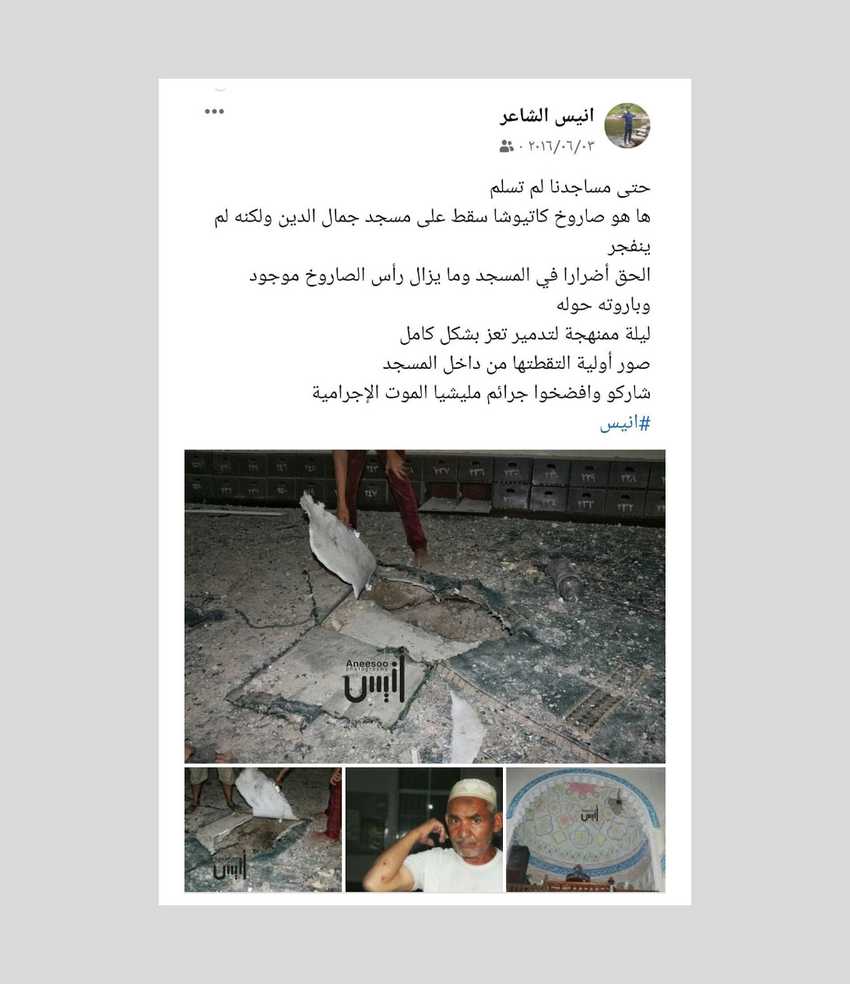
Figure A119
Prayer rugs in mosques have an inscription pointing to the mihrab (a niche in the wall of a mosque). A mihrab indicates the qibla/the direction towards Mecca city in Saudi Arabia. The qibla location in Mecca city can be determined using Google’s Qibla Finder. Based on the qibla direction to northwest of the impact location, and the projectile impact angle, analysis of the open-source content determined that the shell came from the northeast and along the straight line linking the three impact sites.
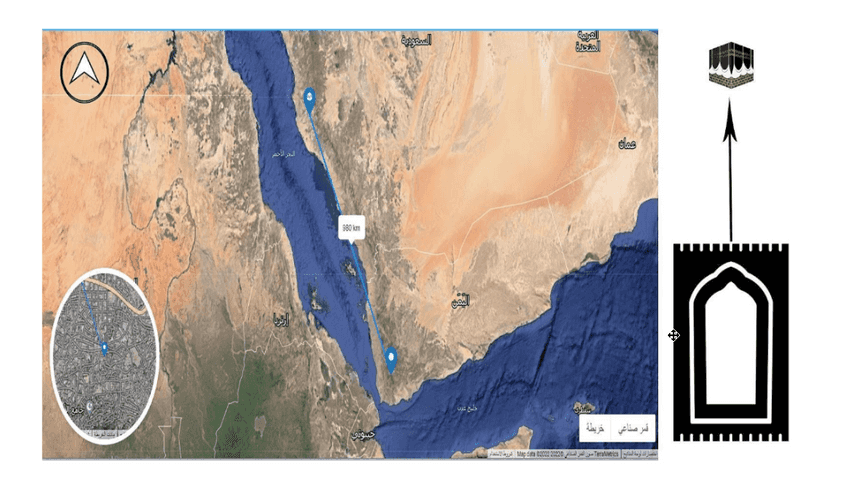
Figure A120 Prayer rugs in mosques have an inscription pointing to the qibla in Mecca city. A screenshot from Google Qibla Finder, showing Mecca northwest of the impact location in Jamal Al-Din mosque
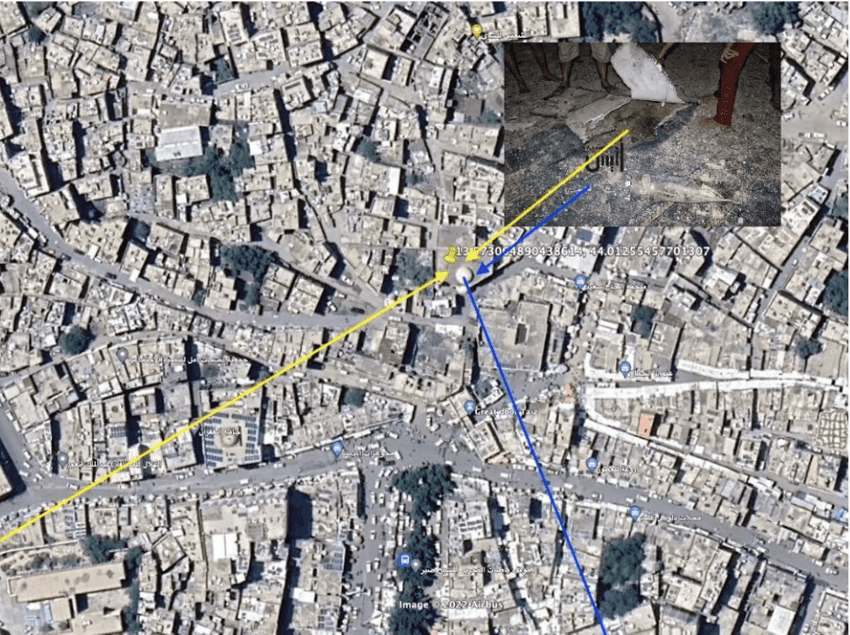
Figure A121 Satellite image from Google Earth, and a photo from Anis Al Shaer’s Facebook account show the shell trajectory (yellow), and the direction of qiblah/north west (blue)
The lines of engagement between the Yemeni Government and the Popular Resistance forces on one hand and the Houthi-Saleh forces are 2 km away along the line from the market site. This area is under the control of the Yemeni Government and the Popular Resistance forces. While the rest of the area, including the heights and camps, along the same line to Taiz International Airport, is under the control of the Houthis.
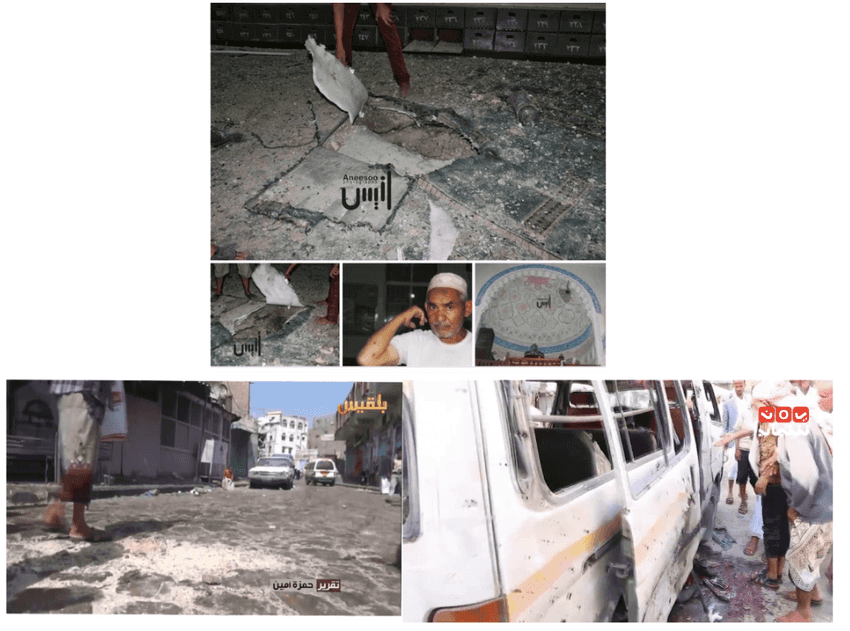
Figure A122 These images show what is claimed to be damage resulting from this specific attack on the mosque and the market. The top photo is from a Facebook post of the mosque after the attack. The bottom left photo of the market is from Yemen Shabab One, and the bottom right photo of the market is from Belqees Channel.
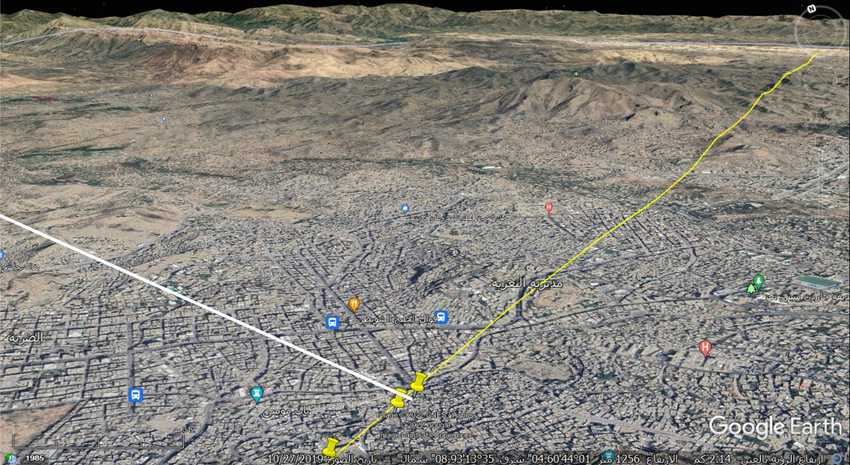
Figure A123 Satellite image from Google Earth, showing the shell trajectory (yellow), and the direction of qiblah/northwest (white)
The satellite image below shows the lines of engagement, between the Yemeni Government and the Popular Resistance forces on one hand and the Houthi-Saleh forces on the other, are 2 km away along the line from the market site. This area is under the control of the Yemeni Government and the Popular Resistance forces. While the rest of the area, including the heights and camps, along the same line to Taiz International Airport, is under the control of the Houthis.
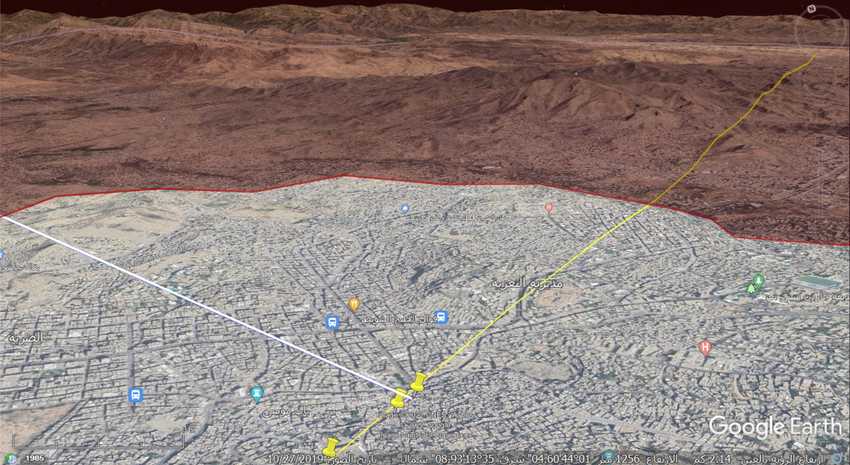
Figure A124 Satellite image from Google Earth, showing areas of military control and lines of engagement. brown color: the Houthis.white color: IRGY and Popular Resistance Forces
As military confrontations on the eastern front of Taiz continued, on 3 June 2016, the Houthi-Saleh forces apparently hit Al-Qahira Castle, which has been used as a military site since the beginning of the war and is next to Hayel School, in which the second shell fell after the shell on the market. Hayel School is a gathering point for the Popular Resistance, commanded by Abu al-Abbas. That suggests that the Houthis were responsible for the attack.
Conclusion
Analysis of open source documentation offered potential supporting evidence for the conclusion that the Houthi-Saleh forces were likely to have directly shelled with 122 mm howitzers a mosque in Taiz Old City of Taiz governorate, on the evening of 3 June 2016. Because the market and the school were both found to be in the same line of trajectory as the mosque, Yemeni Archive’s analysis offers potential supporting evidence for 122 mm howitzers having shelled the market and school as well. However, further analysis would be needed to state this conclusively. The only picture of the ammunition that the Yemeni Archive team obtained was inside the mosque, because it had not exploded. The ammunition that hit the market and the school had exploded, and so no visual evidence of ammunition remnants for these first two impact sites was located. The attack on the market reportedly killed 9 civilians, including women and one child, and injured 11 civilians, including women and a child.